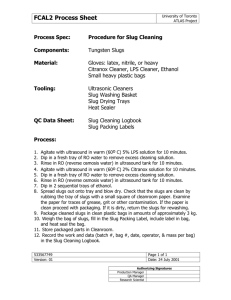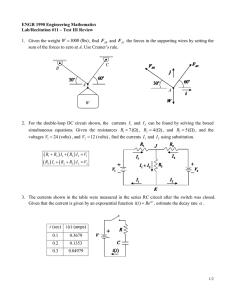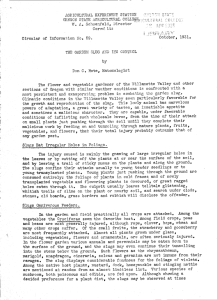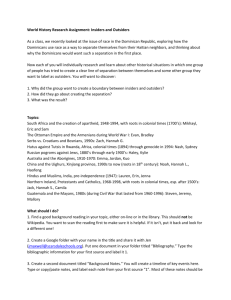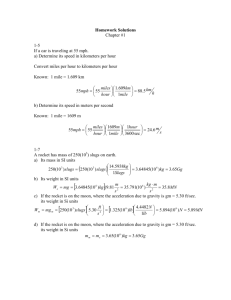Managing Slugs in the Garden and Beyond Introduction
advertisement
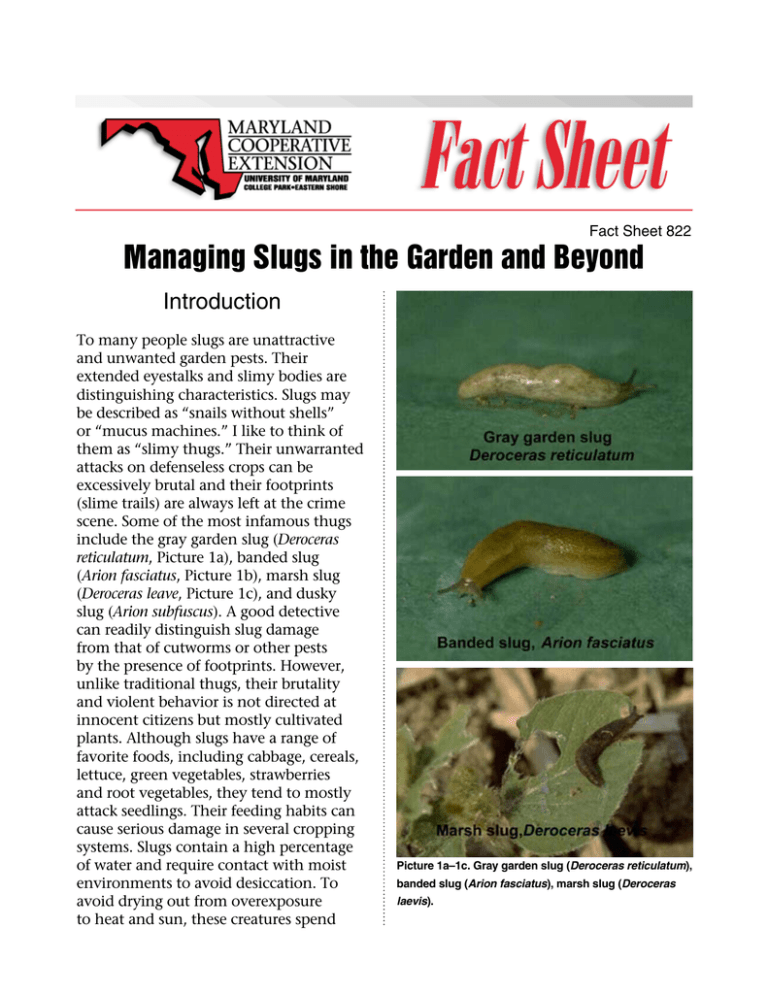
Fact Sheet 822 Managing Slugs in the Garden and Beyond Introduction To many people slugs are unattractive and unwanted garden pests. Their extended eyestalks and slimy bodies are distinguishing characteristics. Slugs may be described as “snails without shells” or “mucus machines.” I like to think of them as “slimy thugs.” Their unwarranted attacks on defenseless crops can be excessively brutal and their footprints (slime trails) are always left at the crime scene. Some of the most infamous thugs include the gray garden slug (Deroceras reticulatum, Picture 1a), banded slug (Arion fasciatus, Picture 1b), marsh slug (Deroceras leave, Picture 1c), and dusky slug (Arion subfuscus). A good detective can readily distinguish slug damage from that of cutworms or other pests by the presence of footprints. However, unlike traditional thugs, their brutality and violent behavior is not directed at innocent citizens but mostly cultivated plants. Although slugs have a range of favorite foods, including cabbage, cereals, lettuce, green vegetables, strawberries and root vegetables, they tend to mostly attack seedlings. Their feeding habits can cause serious damage in several cropping systems. Slugs contain a high percentage of water and require contact with moist environments to avoid desiccation. To avoid drying out from overexposure to heat and sun, these creatures spend Picture 1a–1c. Gray garden slug (Deroceras reticulatum), banded slug (Arion fasciatus), marsh slug (Deroceras laevis). much of their time hidden underneath debris or other objects and between soil crevices. Unfortunately, these behavioral aspects make them difficult to manage. Slugs were mainly viewed as garden nuisances, but increased conservational practices such as direct-drilling, reduced, and no-till operations have increased their presence as agricultural pests. Thus, a shift from conventional to conservational practices has helped create environmental conditions favorable for slug infestation. The purpose of this fact sheet is to provide basic information and discuss different tactics that may be used to manage slug populations in home gardens, and small and commercial farm establishments. unusual because they are hermaphroditic, which means they have both male and female organs. They can lay eggs multiple times during the year and commonly lay clusters of 20-80 eggs during each egg laying bout. Their gelatinous eggs are ~ ¼ inch and are mostly round or oval shaped (Picture 3) and laid in damp shaded soil, under rocks or dead leaves, or underneath mulch and outdoor pots. Slug eggs can lie dormant during dry environmental conditions until sufficient moisture is available. Mild winters followed by wet springs are ideal conditions for population explosions. Slugs grow slowly and generally have a life span of 1 to 5 years. Symptoms and Impact Slug Biology and Behavior Slugs feed on leaves, stems, flowers, and fruits of plants. Damages to plants are usually viewed as irregular holes and scars on the surface of fruits, vegetables, and leaves (Picture 4). Fruits and vegetables in direct contact with the ground are attacked more frequently than those above ground. Small seedlings are especially more inviting and susceptible to slug feeding. Older plants may be able to withstand slug feeding without any yield lost. For example, once a corn crop has passed the five leaf stage the damage is generally superficial. Slugs may consume several times their body weight each day. Their Slugs are usually light gray or black. In order to survive colder climates slugs overwinter as adults and eggs, and then become active during the warm days of early spring. If conditions are favorable this will lead to a rapid increase in population size. Slugs prefer moist conditions. Therefore, in dry weather their activity drops considerably. Slugs are typically nocturnal creatures, feeding mainly at night and during moist, cool, early morning hours. During the day, they seek dark, moist conditions underneath leaves, boards, rocks, and crop debris such as corn stalk or in soil openings (Picture 2). They are typically inactive above ground by day but may feed and reproduce on days in which there are rainy spells, foggy periods, or after irrigation. During summer months when temperatures peak and the soil is dry, slugs may only remain active at night and under closed canopy plants such as legumes and forage crops. However, slugs remain underground during windy periods and hard driving rains. Their nocturnal living arrangement protects them from the sun and natural enemies that are active during the day. Slugs are considered Picture 2. Slug found in open seed trench. 2 barriers, and cultural techniques are among several strategies available to help manage slugs. Similar to managing insect pests, management of slugs is based on understanding their behavior and using this to exploit their weaknesses. For those individuals who have a desire to outsmart slugs, understanding their “mind-set” is of critical importance. For example, slugs have to produce lots of mucus to travel about. Thus, it is much easier for slugs to travel across wet or moist ground. They have to expend far more energy to travel over dry, rough or dusty ground than moist, smooth areas. Thus, keeping the area dry and establishing borders of gravel, sand, or ash around your plants makes it more difficult for slugs to access them. Additionally, if the weather becomes hot and dry more slugs can be tolerated than under moist conditions and thus the solution may be to do nothing. Picture 3. Slug eggs on back of plant foliage. Picture 4. Young corn plant displaying slug feeding damage. mouths are equipped with a radula that contains thousands of backward-pointing teeth. Slugs travel by excreting large amounts of mucus on the soil surface from their foot-like appendage. This slimy trail is a telltale sign that slugs are in the area. Habitat manipulation and sanitation Home garden: Good sanitation practices will discourage slug colonization. Keeping an area free of plant debris, rocks, low growing weeds, logs, and boards will reduce the number of available hiding places that support their colonization. Heavily mulched gardens are ideal habitats for slugs, as they thrive on high humidity and cool temperatures. Spacing plants far enough apart to allow air movement to dry the soil is also useful. Managing Slugs There are several tactical approaches that can be used to help manage slugs. However, when choosing a tactic, one should consider the practicability of the strategy. For example, a tactic used for managing slug problems in a small garden may not be feasible on a small farm or large commercial operation. Similarly, management tactics used on large commercial farms may not be appropriate for smaller operations. The use of chemical baits, good sanitation practices, traps, Commercial farm: The use of row cleaners to move trash and debris away from the cash crop in no-till fields may reduce the risk of slug damage. Row cleaners can enhance seed germination. Quicker, more vigorous plant growth in the spring because of warmer and drier soil may allow plants to outgrow slug damage. 3 Traps of the evening so that it captures slugs throughout the night. However, it can be time consuming to continuously set up beer or yeast traps. Additionally, many individuals may not be willing to make a beer run for slugs, and uninvited guests (e.g., small animals) may help themselves to the free beer. Setting up barriers around plants and use of baits may be feasible for home gardeners but not economically feasible on a larger scale. Home garden: If the aim is to trap slugs, then only those items for this purpose should remain on the soil surface. For example, slugs have been reported to like seeds from various rinds such as melons and will remain underneath melon rinds overnight. Rinds may be placed in gardens at night and in the morning turned over so slugs can be picked off or exposed to predators such as birds. Putting a board down on the garden floor will also work similarly. Armed with a flashlight and set of chopsticks, one may also hunt down slugs at night. Follow the slime trail to your plants where they can be picked off with chopsticks or other accessories and drowned in a container of salty or soapy water. Biological control Home garden: Slugs have several predators such as frogs, toads, birds, fireflies, and beetles. Any manipulations that can be done to attract more natural enemies to the area could be helpful. For example, frogs prefer damp sites and a large part of their diet may consist of slugs. However, these natural enemies may only offer superficial slug control. Additionally, slugs exhibit several defensive behaviors. Some species flip or run in order to escape predators. Others similar to lizards may drop their tail or release distasteful mucus as a deterrent. Another method of trapping and killing often suggested is the use of beer traps. Slugs’ attraction to beer may lead some to think they are heavy drinkers or alcoholics, but slugs are merely attracted to the yeasty smell of beer. Beer is known by many as a “slug magnet.” However, what is not well known is that some beers are more effective “slug magnets” than others. For example, a study indicated that Kingsbury Malt Beverage attracted slugs far better than some other brands. Beer traps can be set by sinking cans or other containers into the ground so that they are 1 to 2 inches above the soil surface. If the container is flush with the soil surface, you run the risk of drowning non-target organisms, such as ground beetles that prey on slugs. However, beer does not have an EPA registration number, so the use of beer as a pesticide is not technically permissible. Slugs are attracted to odors emitted during fermentation, thus yeast may also be used as an attractant. Three teaspoons of yeast per cup of warm water has been reported to work as a slug attractant. Slugs attracted to the smell of yeast crawl into the trap and drown. The trap and bait technique will work best if it is set up in the cool Small farms: In recent years there have been a number of studies conducted to evaluate a slug-parasitic nematode (microscopic worm), Phasmarhabditis hermaphrodita, on slug numbers and damage. This parasitic nematode has been commercially developed in Europe as a biological agent for managing slugs and is capable of infecting and killing a wide range of pest slugs. They do this by entering the dorsal body cavity of the slug and releasing bacteria that stops the slug from feeding at an early stage of development, bringing about its death. Nematodes then continue to mature and reproduce inside the slug’s body. The mechanisms by which these nematodes cause inhibition of feeding and mortality of the host slug are not well understood. Some studies have suggested that slugs 4 plantings are suggested if the problem occurs mid-spring because later planting will allow for warmer and drier soils that will enhance crop growth. In addition, the drier conditions are less favorable to increased slug activity. Good production practices such as appropriately using starter fertilization can have a significant impact on the vigor of plants early on and consequently the amount of slug damage they can sustain. Vigorous growing plants may reach stages less susceptible to slug damage at a faster pace. avoid resting and feeding on soils treated with nematodes. Unfortunately, because these nematodes are not found naturally in the United States, they have not yet been cleared for use in this country. Barriers Home garden: Copper barriers may be used as slug deterrents. When the slime of slugs comes in contact with copper, it causes a reaction similar to a small electric shock and prevents them from crossing it. Any debris, such as leaves, stems or mulch, found on the barrier should be removed or slugs may use these as crossing points. Thus, copper strips may be buried into the ground, pots may be formed with copper around the rim, or copper wire can be placed around the legs of plant benches. Each barrier technique works by deterring or repelling slug movement in the direction of the protected plants. Barriers may not lower the number of slugs in the garden, but it may encourage them to move to a different area. Plows, discs, and other equipment can be used to crush and bury slugs, disrupt their pathways, and remove volunteer food plants. Cultivating the soil may also remove some of the debris used as hiding places and expose the eggs to drying air and predators. This works best when the weather is warming up and slugs are near the soil’s surface. However, these farm activities do not conform to conservation tillage practices. Still there are some actions that can be taken to reduce the potential of conservation tillage practices to enhance slug numbers. For example, during no-till planting, care should be taken to insure that open seed slits in the soil made during planting are closed. These open areas are ideal hangouts for slugs (Picture 2). Additionally, crop damage from slugs is greatest at the seedling stage. Thus, when seeds are planted into seed trenches that remain open, this may place the associated young seedlings in the direct vicinity of slugs. Slugs inhabiting seed furrows begin to hollow out the endosperm within hours after the seed swells with moisture. For late planted soybean, if high numbers of slugs are present, they will get into these open seed furrows and clean out the soybeans. Open seed trenches or furrows may likely occur if no-till planting is carried out when the soil is too wet. Use of covering chains during moist conditions may help close open seed trenches. But the best solution is to avoid no-till planting when the soil Cultural Commercial farms: Keeping the targeted area as dry as possible without damaging the plants makes conditions less welcoming to slugs. This may be helped by using drip irrigation rather than overhead sprinklers and watering in the morning rather than in the evening. Also, if mulch is used it is best to keep it some distance from the base of susceptible plants. This is especially important until temperatures reach above 75°F. Additionally, slugs may be attracted to mulch and compost piles. A strategic approach for fields with lots of slug eggs is to plant the susceptible crop as early as possible. This may allow plants to reach sizes less susceptible to slug damage. For crops that are being damaged in late spring, earlier planting dates are advised to allow adequate growth before slugs become problematic. Conversely, later 5 phosphate have become available. These slug baits are relatively nontoxic, according to their label and thus can be used around pets and wildlife. While less hazardous to pets, slug baits made of iron phosphate may be more costly than metaldehyde baits and often less effective. It is believed that after consumption, the iron phosphate product inhibits the slug from feeding any further. All baits should be broadcasted across the field at the label recommended rate.These baits are less likely to pose a risk to companion animals such as dogs if spread out rather than piled. For optimum results, use of a spreader that achieves even coverage across a field is recommended. However, this may not always be possible if there is a restriction on the product contacting edible portions of crops such as the foliage of leafy vegetables and fruits in strawberry fields. Baits may, however, be placed in bait stations where they are protected from the elements and unlikely to contaminate produce. Slug baits should be applied according to label directions and special attention should be directed to cautions, especially with regard to children and pets. is too wet. Growers can also strive to plant away from areas such as orchards, forests, and bushy areas. Slugs may migrate into the field from these more favorable habitats. Other cultural practices that can reduce slug damage include using trash wheels to remove excess surface litter around seedlings, shifting to conventional tillage practices for at least one growing season, and reduction in the use of manure. Slug numbers and damage to a crop may also be influenced by the preceding cover crop. Researchers have found that slug numbers increased to a greater extent in plots with leguminous cover crops, red clover or vetch, than in plots where ryegrass was grown. Slug populations are often higher in fields that were in sod the previous year or have substantial crop debris on the surface. Every effort should be made to avoid planting susceptible crops in these high risk or wet fields where slugs have been problematic. Chemical Small and commercial farms: The most effective method for managing slugs is application of slug bait products. Baits work by attracting and killing slugs. Their effectiveness depends primarily on the timing of application, frequency of application, and the way they are applied. There is limited material registered from chemical companies in the U.S. available for controlling slugs. The active substance most commonly used is metaldehyde. However, metaldehyde baits are foodbased and an attractive food source to some animals. Thus, these baits present risks to pets and wildlife especially when used incorrectly. Potential mishaps can be avoided by not leaving open bags of metaldehyde baits lying around, cleaning up any spills instantly, and using the product correctly. More recently nonmetaldehyde slug baits made of iron In heavily infested fields, urea-based nitrogen can be applied as a rescue treatment and direct contact irritant at night. This approach is only effective if slugs are actively feeding on plants when the application is made. Poor control has been linked to windy conditions during the night, which discourage slugs from feeding on the upper plant surface. However, the high cost of fertilizer may make this strategy economically unfeasible. Sampling for slugs Small and commercial farms: Ohio State University researchers suggest that sampling fields in early spring is the key to a healthy slug management program and that most field crop injury in spring is from juvenile slugs, not adults. Thus, 6 adults. As such, you will not get a good estimate or relative number of juvenile slugs using this method. in spring, sampling should be directed at finding small juvenile slugs. This is especially important after mild winters that increase their overwintering success and if cool wet conditions prevail causing slow crop growth. Begin checking for slugs before crop emergence, especially in corn, because these pests are known to feed on the germinating corn seeds and sprouts especially if the seed furrow is not completely closed. Priority should be given to susceptible crops and sites with a history of slug problems, wet areas, or areas with heavy surface debris. When sampling, turn over several areas with clods of dirt and surface trash to estimate the number of slugs associated with each plant. One method to sample for slugs in open row crops is to dig holes using a golf-hole digger or similar instrument and cover them with asphalt shingles or other material wrapped in aluminum foil (Pictures 5a & b). After several nights have passed, traps can be checked and slugs counted. Another method is to make a shallow pit just below the soil surface and drop some slug bait into it. The bait can be covered with a wood scrap or similar material as mentioned above and checked later for the presence of dead slugs. A potential problem is that small slugs may not readily go to dug holes or covers like For direct estimates, slugs can be sampled directly on the plants. However, this requires scouting during the late evening or night hours. Currently, it is not possible to relate slug counts to the amount of damage they may cause. So any treatment in response to their counts will be based on a nominal threshold. However, it has been reported that both corn and soybean can tolerate 40% defoliation in vegetative stages without significant yield loss. Thus, it is advised to treat when defoliation of these crops reach 40% or more and slugs are still feeding. Ohio State University researchers recommend that in corn or soybean crops, growers pay close attention to the new leaf material to determine whether the crop is “outgrowing” the injury. If new leaf material is being defoliated, it’s more likely treatment is warranted. For corn, attention should focus on the new leaves in the whorl; for soybean, it’s the new expanding leaflets. For other cropping situations, when it is more of an aesthetic issue, baits may need to be applied early and often. Closing Remarks Increased conservational practices such as direct-drilling, reduced, and no-till operations have increased the importance of slugs in agricultural cropping communities by creating habitats favorable for their establishment and survival. Despite this, slugs have several vulnerabilities and behavioral aspects during their life stages that can be exploited to help manage them. For instance, slugs are attracted to certain odors and thus can be readily baited and killed. They seek moist environments, so actions to reduce moisture, particularly during the night hours, will provide Picture 5 a and b a) Soil pit. b) Cover placed between corn rows for monitoring slug populations. 7 some pest relief. Morning (vs. evening) irrigation, use of drip irrigation versus overhead irrigation, and use of raised beds all may help reduce slug populations. The tendency of slugs to seek protected environments (e.g., dense weeds, corn stalks, grassy and excessively mulched area, cover crops, soil crevices) can be exploited by removing these conditions when possible or using these known hideouts to trap and/or kill slugs. It is our general belief that future research should be devoted to searching for biological control agents that could actively help suppress slugs and should explore ways to minimize slugs’ impact. In some instances those conditions that are most hospitable to slug survival may make slugs more vulnerable to natural enemies. Acknowledgements We thank Dr. Galen Dively for thoughtful conversation and insight regarding slug management. We also thank Dr. Ron Hammond and Joanne Whalen for their attentive review and suggestions, which helped improve the contents of this publication. Pictures are courtesy of Galen Dively. References Anonymous. Integrated Crop Management. Iowa State University, University Extension. http://www.ipm.iastate.edu/ipm/icm/ node/1214/print Bolda, M. 2005. Slug control needed in strawberries. Western Farm Press. http://westernfarmpress.com/mag/farming_slug_control_needed/ Fisher, G. (2006) Revision. Slug control. 2007. Pacific Northwest Insect Management Handbook. http://pnwpest.org/pnw/ insects?27IPMW07.dat Glen, D.M., M.J. Wilson, P. Brain, and G. Stroud. 2000. Feeding activity and survival of slugs, Deroceras reticulatum, exposed to the rhabditid nematode, Phasmarhabditis hermaphrodita: a model of dose response. Biological Control, 17: 73-81. Goh, K.S., R.L. Gibson, and D.R. Speaker. 1988. Gray Garden Slug Deroceras reticulatum (Muller). Cornell Cooperative Extension, Field Crops Fact Sheet No. 102GFS795.00. Henderson, I.F. 1996. Slugs and snail pests in agriculture. BCPC Symposium Proceedings No. 66. The British Crop Protection Council, 450 pp. Iglesias, J., J. Castillejo, and R. Castro. 2001. Mini-plot experiments on slug control using biological and chemical control agents. Annals of Applied Biology, 139: 285-292. Pollock, C. and R. Hammond. 2004. Early sampling key to better slug management. http://www.ag.ohio-state.edu/~news/story. php?id=2840 Shetlar, D.J. 2000. Slugs and their management. Ohio State University Extension Fact Sheet. http://ohioline.osu.edu/hygfact/2000/2010.html Symondson, B. 1996. Slug control. http://www. cardiff.ac.uk/biosi/staffinfo/wocs2.html Vernava, M.N., P.M. Phillips-Aalten, L.A. Hughes, H. Rowcliffe, C.W. Wiltshire, and D.M. Glen. 2004. Influences of preceding cover crops on slug damage and biological control using Phasmarhabditis hermaphrodita. Annual of Applied Biology, 145: 279-284. Managing Slugs in the Garden and Beyond by Cerruti R.R. Hooks and Jermaine Hinds University of Maryland Cooperative Extension Entomology Issued in furtherance of Cooperative Extension work, acts of May 8 and June 30, 1914, in cooperation with the U.S. Department of Agriculture, University of Maryland, College Park, and local governments. Cheng-i Wei, Director of Maryland Cooperative Extension, University of Maryland. The University of Maryland is equal opportunity. The University’s policies, programs, and activities are in conformance with pertinent Federal and State laws and regulations on nondiscrimination regarding race, color, religion, age, national origin, gender, sexual orientation, marital or parental status, or disability. Inquiries regarding compliance with Title VI of the Civil Rights Act of 1964, as amended; Title IX of the Educational Amendments; Section 504 of the Rehabilitation Act of 1973; and the Americans With Disabilities Act of 1990; or related legal requirements should be directed to the Director of Human Resources Management, Office of the Dean, College of Agriculture and Natural Resources, Symons Hall, College Park, MD 20742.
